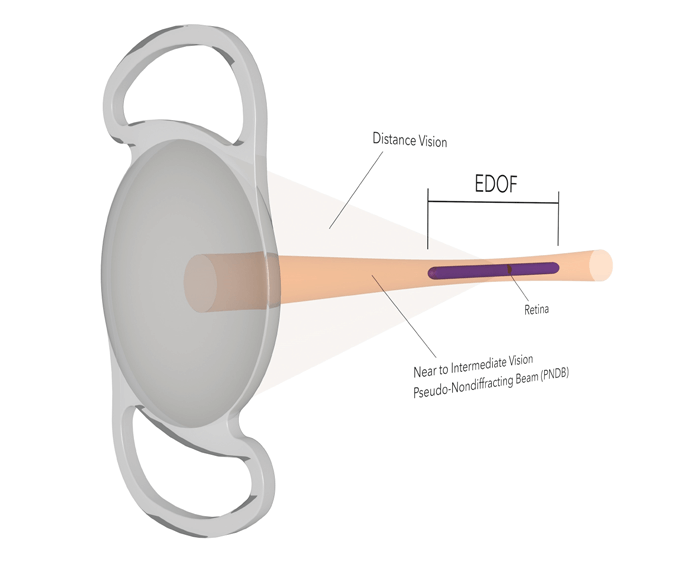
I’m an anterior segment specialist and Chief Surgeon at OnO group based in Switzerland and in France, which was the first practice to offer outpatient eye surgery in Switzerland, 30 years ago. I perform high volumes of cataract surgeries using premium lenses.
I started using the Lucidis EDOF IOL, which is built with SAV-IOL’s Instant Focus Technology, around 2017. I was really curious to see the results of this IOL in my practice, especially in comparison with other EDOF lenses. It was an interesting time: surgeons were using a lot of trifocal lenses, with seemingly great results, but many patients were disappointed with their outcomes, complaining of halos and other photic phenomena. When I began to use the Lucidis IOL, I could finally say to patients, “If you want to see better at all distances and use your glasses as little as possible, choose this lens!” This is why my practice has gone from 40 Lucidis IOL implants in 2017 to the total of 2351 Lucidis IOLs implanted for the entire OnO group, 656 of which were toric Lucidis IOLs. I can report that 94 percent of my patients implanted with Lucidis in our clinic network are either happy or very happy. Only 8 percent of patients still use spectacles on occasion – mostly in poor lighting conditions.
Patient selection
With the Lucidis IOL, I tend to choose patients over 50 years old, who have cataracts, and motivated to lose or greatly reduce their use of spectacles. Corneal astigmatism of these patients should be less than 1.0 D, and their axial length should range from 22 to 25 mm. When implanting these IOLs, I avoid patients with age-related macular degeneration, glaucoma, chronic uveitis, abnormal irises, and other ocular comorbidities. When this is taken into account, I have found that patients over 2 D or myopes over -3 D are always great candidates for the Instant Focus Technology / Lucidis IOL, and those in between these values should have the right expectations. In my experience, for patients with myopia around -8 D, the Lucidis IOL gives better refractive results than laser vision correction, but for those with high myopia (more than -12/-15 D) it is difficult to obtain calculations that are precise enough. It is important to implant a toric Lucidis IOL when the corneal astigmatism is larger than o.50 D.
It is easy to qualify or disqualify patients based on the physical attributes of their visual system. What is more difficult is assessing people’s attitudes – but as surgeons, we should be able to do this, too. I am weary of patients who show signs of depression and seem to put too much emphasis on achieving a perfect result post-surgically. This is where Instant Focus comes in handy – it gives me more peace of mind that even the most psychologically challenging patients are very likely to be happy with their outcomes.
Surgeon experience
Implanting the Lucidis IOL is very straightforward for a well-experienced, skilled cataract surgeon with good biometry data – but the lens has to be well centered. I usually go for a 2.0 mm incision, and I find it very easy to inject the lens, but I find it a little bit more difficult to fold the lens inside the capsule than other IOLs. I advise fellow surgeons to enlarge their incision to be inside the anterior chamber, to reduce risk.
The future
I believe that if this technology wasn’t protected by a patent, competitors would jump on the bandwagon and would copy this technology. Other types of EDOF lenses still suffer from minor issues, which SAV-IOL has been able to successfully resolve. I believe that the IOLs made with the Instant Focus Technology maintain better image quality and exhibit higher pupillary dependency.
If more surgeons were aware of this technology, I believe that they would use it for the vast majority of their patients. It is the future! As of 2022, I believe that Lucidis is the best lens currently available and allows us to meet patient expectations and – quite simply – make them happy! This is why I would like as many surgeons as possible to know about the Lucidis EDOF IOL and its Instant Focus Technology.

Instant Focus, the ultimate EDOF IOL technology, used for all SAV-IOL lenses, is built into the aspheric optical surface at the center of the IOL. This refractive approach doesn’t use any manipulation of spherical aberration. The elongated focal range – not made up of two to three distinct foci as in the case of multifocal IOLs – is generated by an aspheric surface creating light wave interferences, resulting in a non-split beam of light, called pseudo non-diffracting beam. This beam of light provides patients a continuous near to intermediate vision without visual gaps, which means that patients see continuously from 33 to 100 cm – covering most everyday activities such as reading, computer, tablet / smartphone work, or socializing. The rest of the optical surface provides the distance vision, allowing patients to enjoy activities like driving or playing sports. Moreover, most patients experience little to no photic phenomena.
Multifocal
- May result in blurred vision at far and near
- Often result in night halos and glare
- May result in monocular diplopia
- Require neural adaptation
- Result in contrast sensitivity reduction
- The level of acceptance is low as outcomes are uncertain
EDOF
- Don’t generate halos
- Have contrast sensitivity in the normal range
- Don’t require neural adaptation
- For most daily activities patients don’t need correction
- Excellent binocular vision
- The level of acceptance is high
